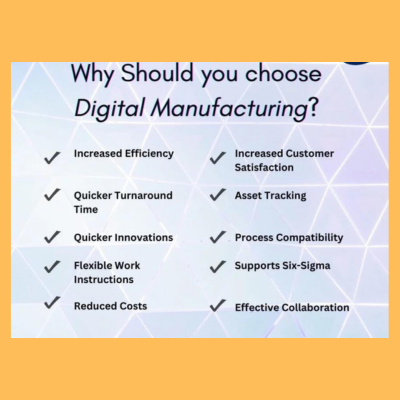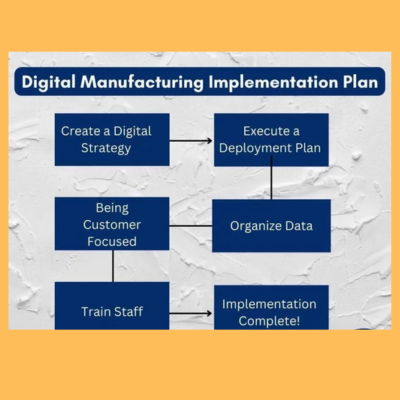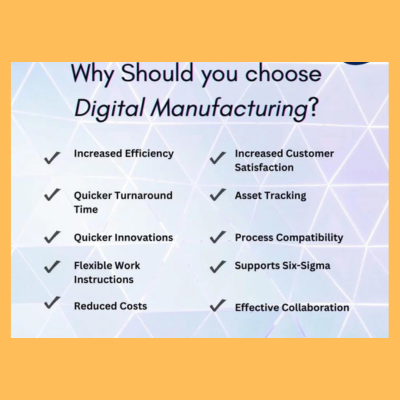Digital manufacturing is a process that uses technology to integrate and optimize manufacturing operations. It involves the use of computer systems to monitor, analyze, and model machines to improve the efficiency and effectiveness of manufacturing processes. Digital manufacturing is becoming increasingly important as companies seek to improve their operations and remain competitive in a rapidly changing global economy.
Digital manufacturing has a long history, dating back to the 1960s when the first computer-controlled machine tools were developed. Since then, the technology has evolved and expanded to include a wide range of digital manufacturing technologies, such as 3D printing, robotics, and artificial intelligence. These technologies have revolutionized the manufacturing industry, allowing companies to produce goods faster, more efficiently, and at a lower cost.
In this article, we will explore the concept of digital manufacturing, its key components, benefits, and challenges. We will also look at some case studies to see how digital manufacturing is being used in real-world applications. Finally, we will examine future trends in digital manufacturing and provide some tips on how to implement digital manufacturing in your business.
Key Takeaways
- Digital manufacturing uses technology to optimize manufacturing processes and improve efficiency.
- Digital manufacturing has a long history and has evolved to include a wide range of technologies, such as 3D printing and robotics.
- Digital manufacturing offers many benefits, but also presents challenges and considerations that must be addressed.
Defining Digital Manufacturing
Digital manufacturing is an innovative approach to manufacturing that uses computer technologies to improve manufacturing operations. It is an integrated process that connects all aspects of production, from design to production and on to the servicing of the final products.
Digital manufacturing technologies link systems and processes across all areas of production to create an integrated approach to manufacturing. This approach allows companies to optimize the manufacturing process, reduce production costs, and increase production efficiency.
Digital manufacturing tools can connect and simplify processes across the production cycle to create a “digital thread” that integrates manufacturing operations to streamline and enhance design, production, servicing, and more. These tools are used to simulate and model processes so that they can be optimized before production begins.
One of the key benefits of digital manufacturing is that it allows companies to produce customized products on a large scale. For example, a company can use digital manufacturing to create a unique design for each customer without incurring the high costs associated with traditional manufacturing processes.
Another benefit of digital manufacturing is that it allows companies to reduce the amount of waste generated during the manufacturing process. By optimizing the manufacturing process, companies can reduce the amount of raw materials and energy needed to produce a product. This, in turn, reduces the environmental impact of manufacturing.
Overall, digital manufacturing is a powerful tool that can help companies reduce costs, increase production efficiency, and create customized products on a large scale. With the rise of computer systems in manufacturing plants, it has become necessary to model, simulate, and analyze manufacturing processes to optimize production. Digital manufacturing is the solution that companies are turning to in order to stay competitive in today’s fast-paced manufacturing environment.
History and Evolution of Digital Manufacturing
Digital manufacturing has been around since the 1970s, but it has evolved significantly over the years. The first computer-aided design (CAD) systems were developed in the 1960s, and these systems were quickly adopted by manufacturers to automate their design processes. By the 1970s, computer-aided manufacturing (CAM) systems were being developed, which allowed manufacturers to automate their production processes as well.
In the 1980s, the concept of computer-integrated manufacturing (CIM) was introduced. CIM was a more comprehensive approach to manufacturing automation, which involved integrating all aspects of the manufacturing process, including design, production, and logistics. CIM systems were expensive and complex, and they were only used by large manufacturers.
In the 1990s, the concept of flexible manufacturing systems (FMS) was introduced. FMS systems were designed to be more modular and flexible than CIM systems, which made them more affordable and easier to implement. FMS systems were used by a wider range of manufacturers, including small and medium-sized enterprises.
In the early 2000s, the concept of digital manufacturing was introduced. Digital manufacturing is an integrated approach to manufacturing that uses computer technologies to improve manufacturing operations. It involves the use of digital models to design, simulate, and optimize manufacturing processes, as well as the use of data analytics to monitor and improve manufacturing operations.
Today, digital manufacturing is becoming increasingly important as manufacturers seek to improve their efficiency, quality, and agility. Digital manufacturing technologies such as the Internet of Things (IoT), artificial intelligence (AI), and automation are being used to optimize manufacturing operations and help manufacturers stay competitive in a rapidly changing market.
Overall, the evolution of digital manufacturing has been driven by the need for manufacturers to improve their efficiency, quality, and agility. As technology continues to evolve, it is likely that digital manufacturing will become even more important in the years to come.

Key Components of Digital Manufacturing
Digital manufacturing combines advanced technologies and software to optimize manufacturing processes, reduce costs, and improve product quality. Here are some of the key components of digital manufacturing:
Computer-Aided Design (CAD)
Computer-Aided Design (CAD) software allows engineers to create precise 3D models of products and parts. CAD software is used extensively in digital manufacturing to design parts and assemblies, simulate their behavior, and optimize their performance.
Computer-Aided Manufacturing (CAM)
Computer-Aided Manufacturing (CAM) software is used to automate the manufacturing process. CAM software takes the 3D models created by CAD software and generates toolpaths that are used to control CNC machines and other automated manufacturing equipment.
Product Lifecycle Management (PLM)
Product Lifecycle Management (PLM) software is used to manage the entire lifecycle of a product, from design to production to disposal. PLM software helps manufacturers to collaborate more effectively, streamline workflows, and reduce costs.
3D Printing and Additive Manufacturing
3D printing and additive manufacturing are technologies that build parts layer by layer using materials such as plastics, metals, and ceramics. These technologies are used extensively in digital manufacturing to create prototypes, tooling, and end-use parts.
Internet of Things (IoT)
The Internet of Things (IoT) refers to the network of physical objects that are connected to the internet and can communicate with each other. In digital manufacturing, IoT devices are used to monitor and control manufacturing processes, collect data, and optimize performance. IoT devices can be used to detect equipment failures, predict maintenance needs, and improve product quality.
Digital manufacturing is a rapidly evolving field that is transforming the way products are designed, manufactured, and delivered. By leveraging advanced technologies and software, manufacturers can improve efficiency, reduce costs, and deliver higher quality products to their customers.
Benefits of Digital Manufacturing
Digital manufacturing has revolutionized the way products are designed, produced, and serviced. With the integration of computer technologies, companies can improve their manufacturing operations, reduce production costs, and increase productivity. Here are some of the benefits of digital manufacturing:
Increased Efficiency
One of the most significant advantages of digital manufacturing is the increased efficiency of a manufacturer’s processes and logistics. A well-integrated, digitized system can help companies monitor, analyze, and model all of their machines to optimize the production process. By leveraging real-time data, manufacturers can identify inefficiencies and make necessary adjustments to improve their processes, reduce waste, and increase output.
Enhanced Customization
Digital manufacturing tools allow manufacturers to create highly customized products that meet the unique needs of their customers. With the ability to simulate and model processes, manufacturers can create prototypes quickly and test different design elements to ensure that the final product meets customer specifications. This level of customization can help companies differentiate themselves from their competitors and increase customer satisfaction.
Reduced Time to Market
Digital manufacturing tools can help companies reduce the time it takes to bring a product to market. By streamlining the design and production process, manufacturers can create and test prototypes more quickly, identify and correct design flaws early in the process, and reduce the time it takes to manufacture the final product. This can help companies get their products to market faster and stay ahead of the competition.
Improved Product Quality
Digital manufacturing tools can help companies improve the quality of their products. By using real-time data to monitor and analyze the production process, manufacturers can identify quality issues early in the process and make necessary adjustments to improve product quality. By reducing the number of defects and improving product quality, manufacturers can increase customer satisfaction and reduce the number of returns and warranty claims.
Overall, digital manufacturing has transformed the manufacturing industry by improving efficiency, customization, time-to-market, and product quality. With the integration of computer technologies, manufacturers can streamline their processes, reduce production costs, and increase productivity to stay ahead of the competition.

Digital Manufacturing Technologies
Digital manufacturing technologies are used to improve manufacturing operations by integrating computer systems to create an integrated approach to manufacturing. This section will explore some of the most commonly used digital manufacturing technologies.
Simulation and Modeling
Simulation and modeling technologies are used to simulate and model manufacturing processes to optimize production and reduce costs. These technologies are used to create virtual models of manufacturing processes, which can be used to test and optimize the design of manufacturing processes before they are implemented. This can save time and money by identifying and correcting potential issues before they occur.
Digital Twins
Digital twins are virtual replicas of physical objects or systems. In the context of manufacturing, digital twins are used to create virtual replicas of manufacturing processes and equipment. These virtual replicas can be used to monitor and optimize the performance of manufacturing processes and equipment in real-time.
Advanced Robotics
Advanced robotics technologies are used to automate manufacturing processes and improve efficiency. These technologies are used to create robotic systems that can perform tasks that are too dangerous or difficult for humans to perform. Advanced robotics technologies are also used to improve the accuracy and precision of manufacturing processes.
Artificial Intelligence and Machine Learning
Artificial intelligence and machine learning technologies are used to analyze manufacturing data and optimize manufacturing processes. These technologies are used to identify patterns and trends in manufacturing data, which can be used to optimize production and reduce costs. Artificial intelligence and machine learning technologies are also used to improve the accuracy and precision of manufacturing processes.
Overall, digital manufacturing technologies are used to improve manufacturing operations by integrating computer systems to create an integrated approach to manufacturing. These technologies are used to optimize production, reduce costs, and improve efficiency.
Digital Manufacturing in Action: Case Studies
Digital manufacturing is transforming the way industries operate by integrating computer technologies to improve manufacturing operations. Here are some examples of how digital manufacturing has been implemented in different industries:
Automotive Industry Example
One of the most significant changes in the automotive industry is the shift towards electric vehicles. Digital manufacturing has played a significant role in this shift by streamlining the production process and making it more efficient. Tesla, for example, uses digital manufacturing to produce its electric vehicles. The company has implemented a “smart factory” that uses robots and artificial intelligence to assemble its vehicles. This has resulted in higher production rates and improved quality control.
Aerospace Industry Example
The aerospace industry is another sector that has benefited from digital manufacturing. Boeing, for example, has implemented a digital manufacturing process that has reduced production time and increased efficiency. The company uses virtual reality and augmented reality to simulate the production process, allowing engineers to identify and fix potential problems before they occur. This has resulted in significant cost savings and improved safety.
Consumer Goods Industry Example
Digital manufacturing has also been implemented in the consumer goods industry. Procter & Gamble, for example, uses digital manufacturing to produce its products. The company has implemented a “smart factory” that uses sensors and data analytics to monitor the production process. This has resulted in improved quality control and reduced waste. The company has also implemented a “digital twin” of its factories, which allows engineers to simulate and optimize the production process.
Overall, digital manufacturing has transformed the way industries operate. By integrating computer technologies, companies can streamline the production process, reduce costs, and improve quality control. These case studies demonstrate the potential of digital manufacturing to revolutionize industries and create new opportunities for growth and innovation.
Challenges and Considerations in Digital Manufacturing
Digital manufacturing presents a number of challenges and considerations that manufacturers must address to ensure successful implementation and operation of these systems. This section outlines some of the key challenges and considerations that manufacturers should be aware of when implementing digital manufacturing systems.
Data Security and Privacy
One of the most critical challenges that manufacturers face in implementing digital manufacturing systems is ensuring the security and privacy of their data. With the increasing use of connected devices and sensors in manufacturing, there is a growing risk of cyber attacks and data breaches. To address this challenge, manufacturers should implement robust data security and privacy protocols that include encryption, access controls, and regular security audits.
Integration with Legacy Systems
Another challenge in implementing digital manufacturing systems is integrating these systems with legacy manufacturing systems. Many manufacturers have invested heavily in their existing manufacturing systems, and it can be difficult to integrate new digital manufacturing systems with these legacy systems. To address this challenge, manufacturers should carefully evaluate their existing systems and identify areas where digital manufacturing systems can be integrated to improve efficiency and productivity.
Skilled Workforce Requirements
Digital manufacturing systems require a highly skilled workforce to design, implement, and operate these systems. This can be a challenge for manufacturers who may struggle to find qualified personnel to fill these roles. To address this challenge, manufacturers should invest in training and development programs to ensure that their workforce is equipped with the skills and knowledge needed to operate these systems effectively.
In summary, digital manufacturing presents a number of challenges and considerations that manufacturers must address to ensure successful implementation and operation of these systems. By addressing these challenges and considerations, manufacturers can unlock the full potential of digital manufacturing to improve efficiency, productivity, and profitability.
The Role of Sustainability in Digital Manufacturing
Sustainability is a vital aspect of modern manufacturing processes. With the rise of digital manufacturing, sustainability has become even more important. Digital manufacturing processes enable manufacturers to optimize their operations, reduce waste, and minimize their environmental impact. By using digital technologies, manufacturers can achieve sustainability goals while improving efficiency and productivity.
One example of digital manufacturing enhancing sustainability is the use of digital twins. Digital twins are virtual replicas of physical assets, such as machines or production lines. They can be used to optimize performance, identify areas for improvement, and reduce waste. For instance, Hitachi has developed a digital twin for each machine at its manufacturing site, which receives real-time data from the machine and provides suggestions for improvement. This process allows for continuous improvement and helps to reduce waste and energy consumption.
Another example of digital manufacturing promoting sustainability is the use of data analytics. Data analytics can be used to identify inefficiencies in the manufacturing process, reduce waste, and optimize resource usage. For instance, a manufacturer can use data analytics to identify the most energy-intensive processes and find ways to reduce energy consumption. By doing so, the manufacturer can reduce its carbon footprint and save on energy costs.
In addition, digital manufacturing can also enable manufacturers to adopt circular economy principles. Circular economy principles aim to minimize waste and maximize the reuse of resources. Digital technologies can help manufacturers to implement circular economy principles by enabling them to track and manage their resources more effectively. For instance, a manufacturer can use digital technologies to track the usage of raw materials and identify opportunities for reuse or recycling.
In conclusion, sustainability is a crucial aspect of digital manufacturing. By adopting digital technologies, manufacturers can optimize their operations, reduce waste, and minimize their environmental impact. Digital twins, data analytics, and circular economy principles are just a few examples of how digital manufacturing can promote sustainability. Manufacturers that prioritize sustainability in their digital manufacturing processes will not only reduce their environmental impact but also improve their bottom line.

Future Trends in Digital Manufacturing
As digital manufacturing continues to evolve, there are several future trends that are expected to emerge. These include:
1. Increased Use of Artificial Intelligence (AI)
AI is expected to become a critical component of digital manufacturing in the coming years. It can help manufacturers to optimize their processes, reduce waste, and improve quality. For example, AI-powered predictive maintenance systems can help manufacturers to identify potential issues before they occur, reducing downtime and improving efficiency.
2. Greater Integration of Digital Twins
Digital twins are virtual replicas of physical assets, processes, or systems. They can be used to simulate and optimize manufacturing processes, reducing the need for physical prototypes. In the future, digital twins are expected to become even more integrated into digital manufacturing, providing manufacturers with real-time insights into their operations.
3. Increased Adoption of Additive Manufacturing
Additive manufacturing, also known as 3D printing, is a process that involves building objects layer by layer. It is already being used in some manufacturing processes, but it is expected to become even more widespread in the coming years. Additive manufacturing can help manufacturers to reduce waste, improve efficiency, and create more complex products.
4. Greater Use of Collaborative Robots (Cobots)
Cobots are robots that are designed to work alongside humans. They can help to automate repetitive or dangerous tasks, freeing up workers to focus on more complex tasks. In the future, cobots are expected to become even more prevalent in manufacturing, helping to improve efficiency and reduce costs.
5. Increased Focus on Sustainability
Sustainability is becoming an increasingly important issue for manufacturers. In the future, digital manufacturing is expected to play a key role in helping manufacturers to reduce their environmental impact. For example, digital simulations can be used to optimize energy usage, while additive manufacturing can help to reduce waste.
Overall, these future trends in digital manufacturing are expected to help manufacturers to improve efficiency, reduce costs, and create more sustainable operations.

